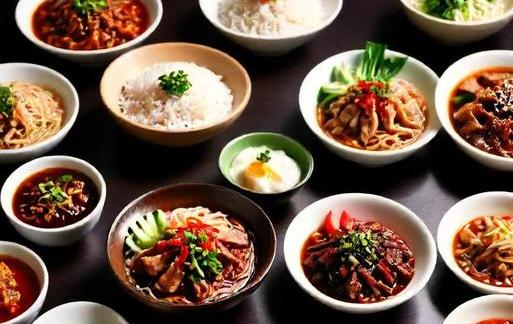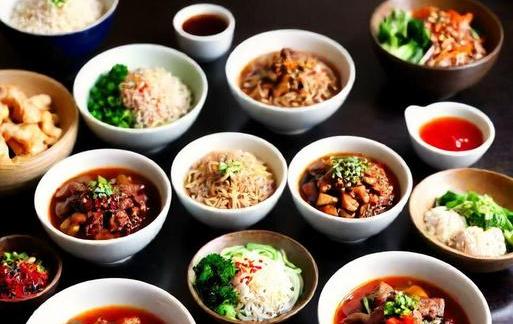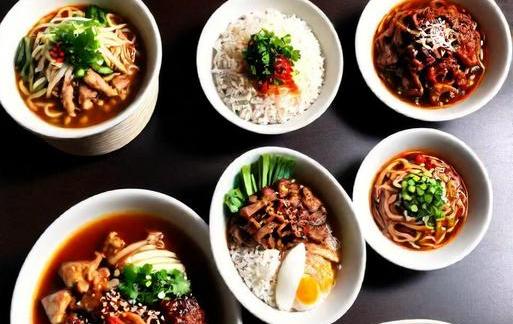- You are here:
- Home »
- Food
- » [REVEALED] Asian Foods That Start With B
[REVEALED] Asian Foods That Start With B
Note: This page contains affiliate links.
As an Amazon Associate, I earn from qualifying purchases when you click on the link, but you are not charged extra.
Asian cuisine is a rich tapestry of flavors, textures, and aromas that have captivated the taste buds of food enthusiasts around the world. From spicy curries to delicate sushi, the diversity of Asian dishes is truly astounding. In this culinary exploration, we will delve into the realm of Asian foods that start with the letter "B." Brace yourself for a gastronomic journey through a variety of delectable dishes from different regions, each with its own unique ingredients, preparation methods, and cultural significance.
Contents
List Of Asian Foods That Start With B

1. Bibimbap (Korea)
Description:
Bibimbap, a quintessential Korean dish, translates to "mixed rice." It is a visually appealing and flavorful dish featuring a bowl of warm white rice topped with an array of colorful vegetables, sliced meat (usually beef), a fried egg, and a dollop of gochujang (Korean chili paste). The dish is meant to be mixed thoroughly before eating, creating a harmonious blend of textures and tastes.
Ingredients:
- Cooked white rice
- Julienne vegetables (carrots, zucchini, mushrooms, and spinach)
- Sliced beef
- Fried egg
- Gochujang (Korean chili paste)
Preparation:
- Cook the rice.
- Saute or stir-fry vegetables individually.
- Grill or stir-fry the sliced beef.
- Fry an egg sunny-side-up.
- Assemble the dish by arranging the rice, vegetables, beef, and egg in a visually appealing manner.
- Serve with a side of gochujang for mixing.
Cultural Significance:
Bibimbap represents the balance of flavors and textures, embodying the principles of Korean cuisine. It reflects the importance of harmony in both taste and presentation.
2. Banh Mi (Vietnam)
Description:
Banh Mi, a Vietnamese sandwich, is a fusion of French and Vietnamese culinary influences. It typically consists of a baguette filled with a variety of ingredients such as grilled pork, pate, mayonnaise, pickled vegetables, and fresh herbs. The combination of savory, sweet, and tangy flavors makes Banh Mi a delightful and satisfying street food option.
Ingredients:
- Baguette
- Grilled pork or other protein options (chicken, beef, or tofu)
- Pate
- Mayonnaise
- Pickled daikon and carrots
- Cucumber slices
- Fresh cilantro and jalapenos
Preparation:
- Slice the baguette and spread pate and mayonnaise on both sides.
- Fill the sandwich with grilled pork or your preferred protein.
- Add pickled daikon and carrots, cucumber slices, and fresh herbs.
- Assemble the Banh Mi and press it gently.
Cultural Significance:
Banh Mi reflects Vietnam’s culinary history, combining French and Vietnamese ingredients to create a unique street food experience. It has become a symbol of the diverse influences that shape Vietnamese cuisine.
3. Biryani (India)
Description:
Biryani is a fragrant and flavorful rice dish that originated in India. It is made by layering marinated meat (often chicken or lamb) with partially cooked rice and aromatic spices. The layers are then cooked together, allowing the flavors to meld and infuse into the rice. Biryani is often garnished with fried onions, mint, and cilantro.
Ingredients:
- Basmati rice
- Meat (chicken, lamb, or beef)
- Yogurt
- Biryani masala (a blend of spices)
- Onions, thinly sliced
- Ghee (clarified butter)
- Fresh mint and cilantro
Preparation:
- Marinate the meat in yogurt and biryani masala.
- Parboil the rice.
- Layer the marinated meat and partially cooked rice in a pot.
- Cook on low heat, allowing the flavors to meld.
- Garnish with fried onions, mint, and cilantro before serving.
Cultural Significance:
Biryani is a staple in Indian cuisine, with regional variations highlighting the diverse culinary traditions across the subcontinent. It is often associated with celebrations and special occasions.
4. Balut (Philippines)
Description:
Balut is a unique and daring Filipino delicacy that may raise eyebrows among the uninitiated. It is a fertilized duck egg with a partially developed embryo, typically boiled and enjoyed with a sprinkle of salt and sometimes accompanied by a vinegar-based dip. Balut is renowned for its rich and distinct flavor, challenging the palates of those willing to try this exotic dish.
Ingredients:
- Fertilized duck eggs
Preparation:
- Select fertilized duck eggs with embryos of the desired age.
- Boil the eggs until the embryo is cooked.
- Crack the egg open, sprinkle with salt, and slurp the contents.
Cultural Significance:
Balut is deeply rooted in Filipino culture and is often considered a street food delicacy. It is not only a source of sustenance but also a symbol of resilience and resourcefulness.
5. Baklava (Middle East)
Description:
Baklava is a sweet and indulgent pastry that originated in the Middle East. Layers of thin phyllo dough are alternated with chopped nuts, usually walnuts or pistachios, and sweetened with honey or syrup. The result is a crispy, flaky, and syrup-soaked dessert that satisfies the sweet tooth with every bite.
Ingredients:
- Phyllo dough
- Chopped nuts (walnuts, pistachios)
- Butter
- Sugar
- Cinnamon
- Honey or syrup
Preparation:
- Layer sheets of phyllo dough, brushing each layer with melted butter.
- Sprinkle a mixture of chopped nuts, sugar, and cinnamon over the layers.
- Repeat the process to create multiple layers.
- Cut into diamond or square shapes before baking.
- Bake until golden brown and crisp.
- Pour honey or syrup over the baked pastry while it’s still warm.
Cultural Significance:
Baklava is a beloved dessert in Middle Eastern cuisine, and its preparation varies across the region. It is often associated with celebrations and special occasions, symbolizing sweetness and prosperity.
6. Bulalo (Philippines)
Description:
Bulalo is a hearty Filipino soup known for its rich and flavorful broth. The soup is made with beef shanks and marrow bones, simmered for an extended period to extract the meaty goodness and collagen from the bones. Vegetables such as corn on the cob, potatoes, and leafy greens are added to complete this comforting dish.
Ingredients:
- Beef shanks
- Marrow bones
- Corn on the cob
- Potatoes
- Peppercorns
- Fish sauce or salt
- Leafy greens (bok choy or pechay)
Preparation:
- Simmer beef shanks and marrow bones in water to create a flavorful broth.
- Add corn on the cob and potatoes to the simmering broth.
- Season with peppercorns and fish sauce or salt.
- Once the meat is tender and the vegetables are cooked, add leafy greens.
Cultural Significance:
Bulalo is a beloved Filipino comfort food, often enjoyed during family gatherings and special occasions. The hearty soup is cherished for its ability to bring warmth and nourishment.
7. Banchan (Korea)
Description:
Banchan refers to an array of small side dishes served in Korean cuisine. These side dishes are meant to complement the main course and provide a variety of flavors and textures. Banchan can include items such as kimchi, pickled vegetables, seasoned seaweed, and marinated tofu, offering a diverse and satisfying dining experience.
Examples of Banchan:
- Kimchi (fermented vegetables, usually cabbage or radishes)
- Namul (seasoned and sautéed vegetables)
- Japchae (stir-fried glass noodles with vegetables)
- Oi Muchim (spicy cucumber salad)
- Dubu Jorim (braised tofu)
Cultural Significance:
Banchan plays a crucial role in Korean dining etiquette, emphasizing communal eating and sharing. The variety of flavors in banchan showcases the culinary diversity within Korean cuisine.
8. Bhel Puri (India)
Description:
Bhel Puri is a popular Indian street food snack that is both flavorful and refreshing. It is made with puffed rice, chopped vegetables, chutneys, and a mix of spices. The combination of crispy puffed rice and the medley of sweet, spicy, and tangy flavors makes Bhel Puri a delightful and addictive snack.
Ingredients:
- Puffed rice
- Chopped onions, tomatoes, and cucumbers
- Sev (crispy chickpea noodles)
- Tamarind chutney
- Mint chutney
- Chaat masala
- Coriander leaves
Preparation:
- Mix puffed rice, chopped vegetables, and sev in a large bowl.
- Add tamarind chutney and mint chutney for flavor.
- Sprinkle chaat masala and toss the ingredients together.
- Garnish with coriander leaves before serving.
Cultural Significance:
Bhel Puri is a beloved street food in India, enjoyed by people of all ages. Its popularity lies in its accessibility, affordability, and the burst of flavors it offers.
9. Bakso (Indonesia)
Description:
Bakso is a traditional Indonesian meatball soup known for its savory broth and hearty meatballs. The meatballs are typically made from a mixture of ground beef or chicken, tapioca starch, and various seasonings. The soup is served with noodles, vegetables, and often accompanied by condiments like sambal (chili paste) and soy sauce.
Ingredients:
- Meatballs (ground meat, tapioca starch, seasonings)
- Broth (beef or chicken)
- Noodles (rice noodles or egg noodles)
- Bok choy or other leafy greens
- Fried shallots
- Sambal and soy sauce (optional condiments)
Preparation:
- Boil the meatballs in the broth until cooked.
- Cook the noodles separately and drain.
- Assemble the soup by placing noodles, meatballs, and vegetables in a bowl.
- Pour the hot broth over the ingredients.
- Garnish with fried shallots and add condiments according to taste.
Cultural Significance:
Bakso is a popular street food in Indonesia, reflecting the country’s diverse culinary influences. It is a comfort food enjoyed by people from all walks of life.
10. Bang Bang Ji Si (China)
Description:
Bang Bang Ji Si, also known as Bon Bon Chicken, is a popular cold dish in Chinese cuisine. It features shredded chicken dressed in a flavorful sauce made with sesame paste, soy sauce, and various seasonings. The dish is often garnished with cucumber strips and peanuts, creating a harmonious blend of textures and tastes.
Ingredients:
- Shredded chicken
- Sesame paste
- Soy sauce
- Rice vinegar
- Sugar
- Garlic and ginger
- Cucumber strips and crushed peanuts for garnish
Preparation:
- Poach or boil chicken until cooked, then shred it.
- Mix sesame paste, soy sauce, rice vinegar, sugar, minced garlic, and ginger to create the sauce.
- Toss the shredded chicken in the sauce until well-coated.
- Garnish with cucumber strips and crushed peanuts before serving.
Cultural Significance:
Bang Bang Ji Si has its roots in Sichuan cuisine and is celebrated for its unique combination of flavors. The dish’s name is derived from the sound of chopping the chicken into shreds, creating a rhythmic and engaging culinary experience.
The world of Asian cuisine is a vast and enchanting realm filled with a myriad of flavors, textures, and cultural influences. From the sizzling streets of Vietnam to the vibrant markets of India, the letter "B" introduces us to a diverse array of dishes that reflect the richness of Asian culinary traditions. Whether you’re savoring the layers of spices in Biryani, indulging in the crispy layers of Baklava, or daring to try the adventurous Balut, each dish tells a story of history, tradition, and the artistry of Asian cooking. As you embark on your culinary journey, remember that the letter "B" is just a small glimpse into the treasure trove of Asian delights waiting to be discovered and enjoyed.
Significance

Asian cuisine is renowned for its rich flavors, diverse ingredients, and cultural significance. In this exploration of Asian foods, we delve into a selection that starts with the letter “B”. From mouth-watering delicacies to everyday staples, the variety is vast and intriguing.
Understanding the significance of Asian foods that start with ‘B’ involves recognizing the cultural and historical contexts that have shaped these culinary delights. In many Asian societies, food is not merely a source of sustenance; it is a reflection of traditions, beliefs, and social bonds.
The ‘B’ foods in Asian cuisine have unique roles in various cultural practices and ceremonies. From being essential components in religious rituals to symbolizing prosperity and good fortune, these foods hold a special place in the hearts of many Asian communities.
Category-Related

Biryani: A Flavorful Rice Dish
One of the most celebrated dishes in Asian cuisine is Biryani. This aromatic and flavorful rice dish originated in the Indian subcontinent and has numerous regional variations. It typically consists of basmati rice, meat (chicken, mutton, or beef), and a blend of spices that can include saffron, cinnamon, cardamom, and cloves. The layers of rice and meat are slow-cooked to perfection, creating a harmonious fusion of textures and tastes.
Banh Mi: Vietnamese Culinary Fusion
Originating from Vietnam, Banh Mi is a delightful fusion of French and Vietnamese culinary influences. This iconic sandwich features a crisp baguette filled with a medley of ingredients such as grilled meats, pickled vegetables, cilantro, and a generous smear of mayonnaise or pâté. The juxtaposition of flavors and textures makes Banh Mi a popular street food not only in Vietnam but also across the globe.
Bibimbap: Korean Harmony In A Bowl
Bibimbap, a staple in Korean cuisine, translates to "mixed rice." This dish comprises a bowl of steamed rice topped with an assortment of seasoned vegetables, chili pepper paste (gochujang), a fried egg, and sliced meat, usually beef. The vibrant colors and diverse flavors come together when the ingredients are mixed before consumption. Bibimbap exemplifies the balance and harmony that are integral to Korean culinary principles.
Balut: A Unique Delicacy
Venturing into the realm of unique and adventurous eating, Balut is a Filipino delicacy that challenges conventional Western notions of what is considered edible. Balut is a fertilized duck embryo boiled and consumed directly from the shell. Widely recognized for its high protein content, Balut is not only a local delicacy but also an exotic dish that attracts curious food enthusiasts from around the world.
Common Themes
Balance Of Flavors
A common theme among many Asian foods starting with ‘B’ is the meticulous balance of flavors. Whether it’s the aromatic spices in Biryani, the contrasting elements in Banh Mi, or the harmonious blend of tastes in Bibimbap, Asian chefs often strive for a perfect equilibrium between sweet, salty, sour, and umami flavors.
Culinary Adaptability
Asian cuisines are known for their adaptability, and this theme is evident in the diverse range of ‘B’ foods. Biryani adapts its ingredients and spices based on regional preferences, while Banh Mi showcases the fusion of French and Vietnamese culinary traditions. This adaptability reflects the dynamic nature of Asian gastronomy, which embraces and transforms influences over time.
Symbolic Significance
Many Asian foods starting with ‘B’ carry symbolic significance in cultural and religious contexts. Biryani, for example, is often prepared during festive occasions and celebrations, symbolizing abundance and communal joy. Similarly, Banh Mi’s amalgamation of ingredients mirrors the cultural blending that occurred during the French colonial period in Vietnam.
Interesting Facts
Biryani’s Royal Heritage
Biryani’s origins can be traced back to the Mughal Empire, where it was considered a royal dish. The word "Biryani" is derived from the Persian word "birian," which means “fried before cooking”. This culinary gem has evolved over centuries, with each region adding its own twist to the recipe.
Banh Mi’s French Connection
The term "Banh Mi" itself is a Vietnamese word for bread, reflecting the French influence on this iconic sandwich. Introduced during the French colonial period, the baguette became a staple in Vietnam, eventually evolving into the Banh Mi we know today.
Bibimbap’s Culinary Symbolism
Bibimbap not only delights the taste buds but also holds cultural symbolism. The arrangement of ingredients in the bowl represents the yin and yang philosophy, emphasizing balance and harmony. The variety of colors, textures, and flavors signifies the diversity and unity of the Korean people.
Balut’s Nutritional Value
While Balut may be considered unconventional by many, it is a nutrient-dense food. Rich in protein, vitamins, and minerals, Balut has been a traditional source of nourishment in Filipino cuisine for centuries.
Conclusion
In conclusion, the world of Asian foods that start with the letter ‘B’ is a fascinating journey through flavors, cultural richness, and culinary ingenuity. From the regal origins of Biryani to the culinary fusion embodied in Banh Mi, and the symbolic harmony found in Bibimbap, each dish tells a story of its own. Balut, with its unique and acquired taste, adds a touch of adventurous exploration to the culinary landscape.
The common themes of flavor balance, culinary adaptability, and symbolic significance underscore the depth and complexity of Asian cuisines. As we explore the interesting facts behind these ‘B’ foods, we gain a deeper appreciation for the historical, cultural, and nutritional aspects that contribute to their uniqueness.
In the grand tapestry of Asian culinary traditions, these ‘B’ foods stand as testaments to the artistry and diversity that continue to captivate food enthusiasts worldwide. Whether enjoyed for their cultural significance, bold flavors, or nutritional value, these Asian foods that start with ‘B’ invite us to savor the rich tapestry of tastes that define this vibrant and dynamic culinary landscape.


